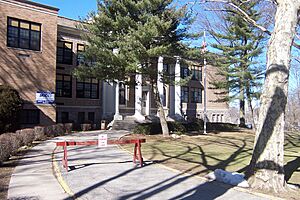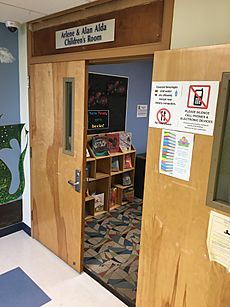Leonia, New Jersey facts for kids
Quick facts for kids
Leonia, New Jersey
|
||
|---|---|---|
|
Borough
|
||
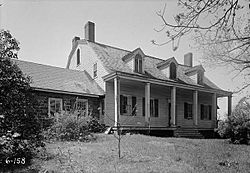
Vreeland House
|
||
|
||
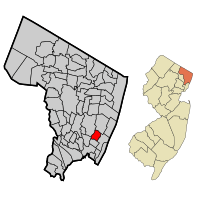
Location of Leonia in Bergen County highlighted in red (left). Inset map: Location of Bergen County in New Jersey highlighted in orange (right).
|
||
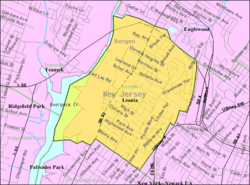
Census Bureau map of Leonia, New Jersey
|
||
| Country | ||
| State | ||
| County | Bergen | |
| Incorporated | December 5, 1894 | |
| Government | ||
| • Type | Borough | |
| • Body | Borough Council | |
| Area | ||
| • Total | 1.63 sq mi (4.22 km2) | |
| • Land | 1.52 sq mi (3.94 km2) | |
| • Water | 0.11 sq mi (0.27 km2) 6.50% | |
| Area rank | 435th of 565 in state 56th of 70 in county |
|
| Elevation | 85 ft (26 m) | |
| Population
(2020)
|
||
| • Total | 9,304 | |
| • Estimate
(2023)
|
9,303 | |
| • Rank | 255th of 565 in state 42nd of 70 in county |
|
| • Density | 6,109.0/sq mi (2,358.7/km2) | |
| • Density rank | 89th of 565 in state 25th of 70 in county |
|
| Time zone | UTC−05:00 (Eastern (EST)) | |
| • Summer (DST) | UTC−04:00 (Eastern (EDT)) | |
| ZIP Code |
07605
|
|
| Area code(s) | 201 | |
| FIPS code | 3400340020 | |
| GNIS feature ID | 0885276 | |
Leonia is a small town, called a borough, in Bergen County, New Jersey. It's a suburb of New York City, located close to the George Washington Bridge. In 2020, about 9,304 people lived there.
Leonia became a borough on December 5, 1894. This happened during a time when many new boroughs were being created in Bergen County. A small part of Leonia was later used to form the Township of Teaneck in 1895. New Jersey Monthly magazine once named Leonia the 31st-best place to live in New Jersey.
Contents
Leonia's Past: A Look at Its History
Leonia was first home to the Hackensack tribe of Native Americans. About 1,000 people lived here before Europeans arrived. During the American Revolutionary War, the area was known as the "English Neighborhood."
European farmers, mostly Dutch and English, settled here in 1668. This makes Leonia one of the oldest communities in New Jersey. Back then, about a third of the population were African slaves. Leonia was a quiet farming town on the western side of the Palisades cliffs. Because it was close to New York City and its universities and theaters, many artists and thinkers chose to live here in the 20th century.
The town's economy, which was mainly farming, grew a lot in the late 1800s when train service started. Leonia was first called West Fort Lee. In 1865, town leaders like J. Vreeland Moore renamed it "Leonia." This name honored General Charles Lee from the American Revolutionary War, who also inspired the name of Fort Lee.
In 1899, a man named Artemus Ward bought a large piece of land in Leonia. He started the Leonia Heights Land Company to build and sell homes. His advertisements brought many smart people and artists to Leonia. They liked the town's small size, culture, and location. This led to Leonia being nicknamed the "Athens of New Jersey."
In 1915, Harvey Dunn started the Leonia School of Illustration. This helped create a community of artists in the town. By the 1930s, Leonia had a very high number of residents listed in Who's Who in America. Also, 80% of its residents had graduated from college! With easy access to ferries and trolleys, Leonia became a home for many creative people, including five Nobel Prize winners.
For 200 years, one of Leonia's main roads, Grand Avenue, was called the English Neighborhood Road. It was an important route during colonial times. Leonia was also a key location during the American Revolution and a training area for soldiers in the American Civil War.
Some important historic places in Leonia include the Civil War Drill Hall and Armory. The Cole-Allaire House, built around 1765, is the oldest home in the borough. Both are listed on the National Register of Historic Places. The Vreeland House, built in 1786, is also on the list.
Leonia celebrates "Leonia Day" every year on the third Sunday in May.
Leonia's Location and Natural Beauty
Leonia covers about 1.63 square miles (4.22 square kilometers). Most of this is land, with a small part being water. The center of the borough is about 85 feet (26 meters) above sea level. The western part can be as low as 5 feet (1.5 meters), and the eastern part can reach 318 feet (97 meters).
Leonia shares its borders with several other towns in Bergen County. These include Englewood, Fort Lee, Palisades Park, Ridgefield Park, and Teaneck.
Leonia is known as a Tree City USA. This means it has been recognized for its efforts to plant and care for trees.
Leonia's Population Over Time
| Historical population | |||
|---|---|---|---|
| Census | Pop. | %± | |
| 1900 | 804 | — | |
| 1910 | 1,486 | 84.8% | |
| 1920 | 2,979 | 100.5% | |
| 1930 | 5,350 | 79.6% | |
| 1940 | 5,763 | 7.7% | |
| 1950 | 7,378 | 28.0% | |
| 1960 | 8,384 | 13.6% | |
| 1970 | 8,847 | 5.5% | |
| 1980 | 8,027 | −9.3% | |
| 1990 | 8,365 | 4.2% | |
| 2000 | 8,914 | 6.6% | |
| 2010 | 8,937 | 0.3% | |
| 2020 | 9,304 | 4.1% | |
| 2023 (est.) | 9,303 | 4.1% | |
| Population sources: 1900–1920 1900–1910 1910–1930 1900–2020 2000 2010 2020 |
|||
In 2010, Leonia had 8,937 people living there. This number grew to 9,304 by 2020. The town has seen its population grow steadily over the years.
Arts and Culture in Leonia
Leonia is a lively place for arts and culture. It is home to the Players Guild of Leonia, which is New Jersey's oldest theater group. They have been putting on plays since 1919! They perform all kinds of shows, from comedies to musicals. In 1940, their play One Mad Night was the first three-act play ever shown on television. Since 1963, they have also put on a special Children's Show each spring. The Guild performs at the historic Civil War Drill Hall Theatre.
Since 2000, Leonia has also hosted Summerstage at Leonia. This group puts on a big Broadway-style musical for families every summer. These shows are now held at the Civil War Drill Hall Theater.
The Leonia Chamber Musicians Society, started in 1973, is made up of professional musicians who live in Leonia. They perform classical music concerts four times a year. Leonia also has outdoor sculptures and the Erika and David Boyd Sculpture Garden, which helps make art part of the community.
Parks and Fun Things to Do
Leonia has five public places for recreation. The Leonia Swim Club is the only one that requires a membership fee. Other places include Wood Park, Sylvan Park, and the Recreational Center. The Recreational Center has an indoor basketball court.
Overpeck County Park is a large county park that includes parts of Leonia. This park is home to the county's memorial for the World Trade Center.
A fun place to visit is Field Station: Dinosaurs. It's a dinosaur-themed park inside Overpeck County Park. It has 32 moving dinosaurs that look very real!
Learning in Leonia: Schools and Education
Leonia has its own public school system. Students from pre-kindergarten all the way through twelfth grade attend these schools. The district has three schools:
- Anna C. Scott Elementary School (PreK–4)
- Leonia Middle School (grades 5–8)
- Leonia High School (grades 9–12)
Students from Edgewater also come to Leonia's middle and high schools. For students looking for special programs, the Bergen County Technical Schools offer advanced courses. These include the Bergen County Academies and the Bergen Tech campus.
Getting Around Leonia: Transportation
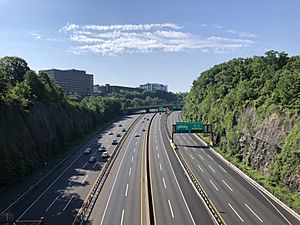
Leonia has about 23 miles of roads. Major roads include Route 93 (Grand Avenue), which runs through the middle of town. Interstate 95 (the New Jersey Turnpike) also passes along the northern edge of Leonia.
To help with traffic, Leonia has a rule that stops non-residents from using local streets during busy rush hours. This rule applies to all streets except Fort Lee Road, Grand Avenue, and Broad Avenue.
For public transportation, NJ Transit buses connect Leonia to places like the Port Authority Bus Terminal in Midtown Manhattan and the George Washington Bridge Bus Terminal. Rockland Coaches also provides bus service.
There's a plan called the Northern Branch Corridor Project to bring passenger train service back to Leonia. This would extend the Hudson-Bergen Light Rail and include a station in Leonia.
Famous People from Leonia
Many interesting people have lived in or are connected to Leonia. Here are just a few:
- Ailee (born 1989), a singer
- Alan Alda (born 1936), a famous actor
- Arlene Alda (born 1933), a photographer and author
- Freddie Bartholomew (1924–1992), a child actor
- Pat Boone (born 1934), a singer
- Anthony Bourdain (1956–2018), a well-known chef and TV personality
- Carolee Carmello (born 1962), an actress
- Robin Cook (born 1940), a doctor and novelist
- Sammy Davis Jr. (1925–1990), a famous entertainer
- Enrico Fermi (1901–1954), a Nobel Prize-winning physicist
- Maria Goeppert Mayer (1906–1972), a Nobel Prize-winning physicist
- Buddy Hackett (1924–2003), a comedian
- Toomas Hendrik Ilves (born 1953), who became the President of Estonia
- Phil Jackson (born 1945), a famous basketball coach
- Willard Libby (1908–1980), a Nobel Prize-winning scientist who helped create radiocarbon dating
- Robert Ludlum (1927–2001), an author
- Mary Beth Peil (born 1940), an actress
- Carmel Quinn (1925–2021), a singer
- Gene Shalit (born 1926), a longtime film critic
- Al B. Sure! (born 1968), a singer and producer
- Harold Urey (1893–1981), a Nobel Prize-winning chemist
See also
 In Spanish: Leonia (Nueva Jersey) para niños
In Spanish: Leonia (Nueva Jersey) para niños






